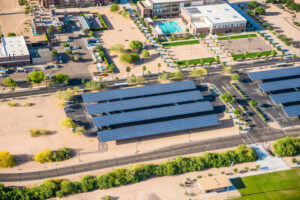 With Google data centers and their offices right on track to be 100% powered by renewable energy by the end of 2017, corporations stand to be one of the most powerful advocates for clean energy throughout the United States. But, since not all businesses have the lucrative resources at their fingertips as Google does, property owners tend to face a number of barriers when pursing their efficiency goals, both financial and non-financial.
With Google data centers and their offices right on track to be 100% powered by renewable energy by the end of 2017, corporations stand to be one of the most powerful advocates for clean energy throughout the United States. But, since not all businesses have the lucrative resources at their fingertips as Google does, property owners tend to face a number of barriers when pursing their efficiency goals, both financial and non-financial.
As a resource to support building owners, the solar energy engineers at KMB have put together a list of four common barriers surrounding renewable energy in commercial real estate along with solutions to overcome these challenges.
Renewable Energy in Commercial Real Estate
A recent Advanced Energy Economy (AEE) report found that of the Fortune 100 companies, 71 companies currently have renewable energy or sustainability targets, up from 60 just two years prior. As a greater percentage of commercial real estate (CRE) properties strive to meet aggressive sustainability goals, the opportunities for renewable energy investments in solar have increased.
But executing corporate renewable energy comes with a few challenges.
1. Uncertainty and Misunderstanding
A common barrier to pursuing renewable energy goals simply starts with a lack of resources and understanding. Risk averse property owners tend to be reluctant to invest in emerging energy efficiency technologies due to an uncertainty surrounding performance and payback.
To prevent any misunderstandings and achieve a successful collaboration, communication is a critical component. At KMB, for example, we take a systematic, design-driven approach to develop comprehensive engineering solutions for our clients, guiding projects from conception through site acquisition, engineering and construction; guiding clients through every step of the way.
2. Cost Concerns
While the cost of installing solar panels has been in a steady decline since 2010, access to financing still remain a common barrier. From upfront capital, debt aversion, high development costs, and long payback periods, property owners may feel constrained.
One of the primary benefits aimed to help investors offset solar installation costs is the federal tax credit program which allows developers to claim of up to 30 percent of their solar installation costs. Although it was originally scheduled to expire at the end of 2016, Congress recently extended the federal solar investment tax credit for five more years, which is good news for property owners.
In addition to tax credits, there are a number of additional financial support options for companies to finance their clean, renewable energy projects.
3. Space Limitations
In a commercial real estate project, solar panels are often installed on rooftops or as a canopy installation above parking lots. And as technology evolves, more options, such as building-integrated photovoltaics (BIPV) that allow the integration of solar cells directly onto a structure’s outer layer, are becoming available.
But between site alignment, structural and roof conditions, and electrical configurations, several factors will need to be taken into consideration. This is why the first step to properly assess PV design and layout is to consult with an experienced firm.
4. Building Ownership
Whether for an office building, retail or industrial, some commercial real estate properties have complicated tenancy agreements which can make it initially challenging for those who are not property owners to consider the addition of solar. For landlords and tenants who are evaluating the installation of solar, the U.S. Department of Energy’s Better Buildings Alliance program put out the report, Promoting Solar PV on Leased Buildings Guide (Benefits, Barriers and Strategies). This report directly addresses the specific barriers to installing solar PV on leased buildings and strategies to overcome them.
Renewable Energy Services by KMB
By understanding the above barriers and network of strategies to overcome them, renewable energy opportunities will become more achievable in the commercial real estate sector, paving the way for ambitious energy efficiency goals.
Contact the experts at KMB to find out more about renewable energy for your next commercial real estate project.